Features
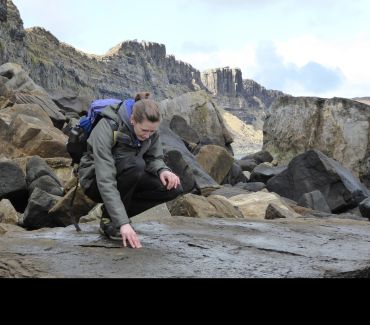 Dr Elsa Panciroli during fieldwork on the Isle of Skye. Credit: Elsa Panciroli/Davide Foffa
Dr Elsa Panciroli during fieldwork on the Isle of Skye. Credit: Elsa Panciroli/Davide Foffa
I am a palaeontologist who uses X-ray tomography and digital visualisation to understand the anatomy and growth of the first mammals and their closest relatives. My work focuses on mammals from the Mesozoic, the era of Earth’s history lasting from about 252 to 66 million years ago, comprising the Triassic, Jurassic, and Cretaceous Periods.
Of course, this includes giant dinosaurs, but it is also when the foundations were laid down for all the modern groups of animal life, including mammals, birds, reptiles, amphibians, and lizards.
People often assume mammals only appeared after the asteroid wiped out the non-bird dinosaurs, but that is not the case. Mammals appeared in the Triassic, at the same time as the dinosaurs, they were diverse and exploited a variety of different ecological niches. The group to which mammals belong stretches back even further in time, and is much more exciting than most people realise.
In traditional school text books, the dinosaurs are shown as the dominant species and the mammals as tiny things, almost an afterthought, scurrying away in the background. But these early mammals were actually highly successful?
Yes indeed – mammals may have been small during the Mesozoic but they were undeniably successful little animals. Many were insect-eaters, but there were also herbivores and carnivores. They were playing a fundamental role in the wider ecosystem. Some could glide like flying squirrels, others could dig like moles or were semi-aquatic. Furthermore, they were also doing something really exciting by forming a new, unique type of organism: one with warm-blood and fur that gave birth to live young. This had never been done before.
You have carried out a lot of fieldwork on the Isle of Skye. What makes this site so special?
The Kilmaluag Formation on the Isle of Skye, Scotland, provides one of the richest Mesozoic vertebrate fossil assemblages in the UK, and is emerging as one of the most important globally for Middle Jurassic tetrapods. It compares with localities such as Morrison Formation in North America, or the Yanliao Biota in China. Fewer species have been found on Skye, but they are exceptionally complete and well preserved. I have been doing fieldwork there since 2016, but I grew up in the Highlands and Islands, so the area is very special for me. As someone who loves the mountains, being able to work in sight of the Cuillin always feels special.
What is it like doing fieldwork there?
I mainly work on the southern part of the island, where rocks from the Middle Jurassic are exposed on the seashore and eroded very slowly by the waves. Normally we only have time to visit one site each day and this will be dictated by the tide times. The area is a Site of Special Scientific Interest (SSSI), as well as falling under Scotland’s new Nature Conservation Order (NCO) designation, for its geology, including fossils.
We do not just collect anything on the off-chance it contains a fossil. We make a judgement call on which rocks look the most promising, and only collect those. Usually, only a tiny fragment of fossil is visible on the rock surface and it is often obscured by seaweed and limpets. So it can be hard to tell how much more may be hidden inside.
Tell us about your work at the Oxford University Museum of Natural History (OUMNH)
The OUMNH has an impressive collection of Mesozoic mammal fossils collected locally at Stonesfield and at Kirtlington. They come from the same age rocks as Skye, so I use them to compare with the new Scottish fossils we find. The Stonesfield specimens are the first Mesozoic mammals fossils ever identified, back in the early 19th Century, making them historically important as well as scientifically invaluable. The specimens from Stonesfield are almost entirely individual teeth – no bigger than grains of cous cous. But we can still work out an incredible amount from these, especially using new techniques such as synchrotron scanning to examine the microstructure. From this we can work out their age and how quickly they grew.
Tell us about your book Beasts Before Us - The Untold Story of Mammal Origins and Evolution. How did that come about?
Most books about mammalian evolution start at the end of the Cretaceous, but their evolution stretches right back over 300 million years. I write about the incredible creatures related to mammals that lived long before the dinosaurs. The book also tells untold human tales; of indigenous people who knew about these fossils long before European settlers appeared, and pioneering female scientists who ought to be household names.
I first started writing about these amazing things when I was a Masters student. Eventually, I realised I had more than enough material to write a book. I pulled together all my blogs, published articles and notes, then organised two months to write the book. Then there was a global pandemic… so I ended up with a lot of free time to finish the manuscript. It was published in June 2021, and the feedback has been so positive. I was so excited when The New York Times review called it ‘smart, passionate and seditious’ - I don’t think many books about fossils can claim to incite rebellion! It also led to lots of talks and outreach work.
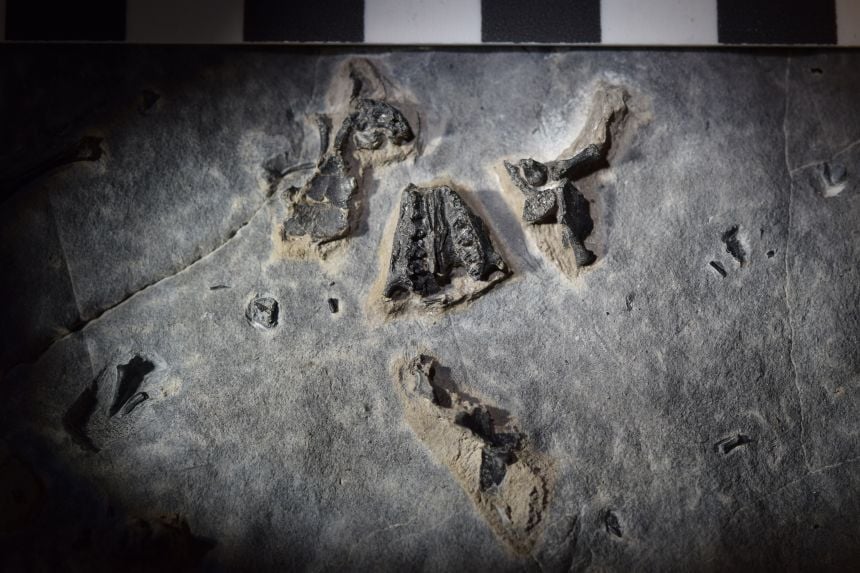 Skull bones of the Jurassic mammal Borealestes serendipitus from the Isle of Skye. Credit: Elsa Panciroli
Skull bones of the Jurassic mammal Borealestes serendipitus from the Isle of Skye. Credit: Elsa PanciroliAnd you have a new book out too?
Yes, The Earth: A Biography of Life came out in April 2022. It uses a series of different organisms – including plants, single-celled organisms and animals – to take you through the great events and evolutionary innovations in earth’s history. It is very visual too, with stunning illustrations, including some by the talented palaeoartist Grace Varnham. There are so many amazing stories in evolutionary research I could write a book every year and I still would not tell everything. The book has inspired the upcoming exhibition Connected Planet at the University of Oxford Museum of Natural History; it will explore the oceans, land, and air around us to witness this dynamic connection and see what happens when the balance tips.
You are also quite an artist…
I don’t think of myself as an artist, but I do enjoy creating visual interpretations of the fossil specimens we discover. The art world can be a bit dismissive about palaeoart, and it is sometimes portrayed as just drawing dinosaurs for children. But modern palaeoart is a dynamic and cutting-edge specialism that just happens to depict extinct animals.
Really good palaeoartists need to know a lot about the science of palaeontology, besides animal anatomy and behaviour. These artworks serve a really important purpose in acting as a bridge between scientists and the public.
Were you always interested in geology and ancient mammals?
As a child, I was absolutely fascinated by rocks and used to collect them everywhere I went. But, growing up in the rural highlands (my primary school only had about 15 pupils), I didn’t have access to libraries and museums and I couldn’t learn much about the science of geology, so I would just make up my own names for the rocks I collected. After finishing secondary school, I didn’t know what I wanted to study, so I just started working and did all sorts of jobs from working in garment factories to cleaning houses. I travelled to various countries and in my late 20s I realised the one thing that always interested me was the natural world. So I enrolled at the University of the Highlands and Islands as a mature student to study Environmental Sciences.
At first, I expected to go into conservation, but in one class we looked at palaeoclimatology, and that got me thinking about deep time and the study of rocks and fossils – stuff that was properly old, millions of years. And that was it, my course was set.
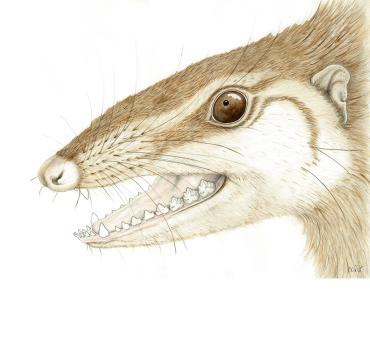 Palaeoart reconstruction of the Jurassic mammal Wareolestes rex. Artist: Elsa Panciroli
Palaeoart reconstruction of the Jurassic mammal Wareolestes rex. Artist: Elsa Panciroli
From there, I did an MSc in Palaeobiology at the University of Bristol, studying ankle bones in fossil mammals. The shape of the ankle is linked to how an animal moves, so I used them to predict whether a fossil species was a digger, a climber, and so on. It is amazing what you can tell about a species’ lifestyle from a single tiny bone.
In 2015 I started a PhD at National Museums Scotland on Scottish mammal fossils from the Middle Jurassic, which is when I started working on the Kilmaluag Formation on Skye. And I have pretty much continued this work up to today, joining Oxford University’s Department of Earth Sciences in 2019. I took up my current role as a Leverhulme Early Career Research Fellow at Oxford University Museum of Natural History in 2020.
What would the young Elsa think of your work now?
I think she would be amazed I was spending my time studying really cool fossils in Scotland. When I was a child, I always wished experts would visit our school and teach us more about rocks and fossils. Remembering this inspired me to create the Scottish Fossil Workshops programme, which was a two-hour workshop I created in 2019. It was specifically designed for primary schools in rural parts of Scotland – places that don’t usually get school visits because they are hard to get to, or don’t have very many pupils. I even returned to my own school.
What is next? Where do you see yourself in the future?
I am not the sort of person who makes 10 or even five year plans, I like to take opportunities as they come. I will definitely keep writing books, and I feel there are so many exciting niches within palaeontology and questions to ask, I could dedicate my entire career to answering them, funding permitting!
By Dr Louise Dalton and Dr Elizabeth Rapa of Oxford's Department of Psychiatry.
Every day, thousands of parents and grandparents are diagnosed with serious health conditions such as cancer, lung or heart disease. They are then faced with the unenviable task of sharing this information with the children they love.
Research has shown that effective communication with children about parental illness has long term benefits for children and their family’s physical and mental health. These include better child psychological well-being, as well as lower reported symptoms of depression, anxiety and behavioural problems. It also has benefits for parental mental health, adherence to treatment (such as following the prescribed drug regime) and family functioning.
However, adults find sharing a diagnosis with children one of the most difficult experiences. Understandably, they want to protect children from distress and many feel uncertain about whether children need to be told, or when and how to navigate these sensitive conversations. Yet, children are “astute observers” and are often acutely aware of changes within the family. Silence about what is happening risks children misinterpreting the situation and worrying alone, without access to the emotional support they need.
Previous research has found that patients want help from their clinical team to think about what, how and when to share their diagnosis with children, or how to answer questions such as “Are you going to die?” – but often report finding this support difficult to find. However, few studies have asked healthcare professionals about how they perceive their role regarding the needs of patients’ wider families. A team from the Department of Psychiatry interviewed 24 NHS clinicians from different professional backgrounds and working across a range of specialties to find out more about their views and experiences regarding the needs of patients’ children.
Our latest study, published in PLOS One, found that although patient’s family details were often recorded, this information was not routinely used to help patients share their diagnosis with children. In other situations, patients’ relationships with children were rarely or never identified.
The NHS healthcare professionals who took part reported feeling uncertain about asking patients about what children understand. They feared that they would make the situation worse or upset their patients.
“What can I say, what if they are in pieces, what do I do with that at that time of day? It seems a bit crass to enquire about something you aren’t in a position to help with.” GP
“Your worst fear is saying the wrong thing” Oncology
It was also frequently assumed that someone else in the clinical team would talk to the patient about their children, but often this meant opportunities for these conversations were missed.
“How that is dealt with, I am not really in the loop. […] So you don’t really know what happens to those children in terms of who says what to them. Someone might, but not me.” Surgery
Because you are talking to them [adult patient] directly, you tend to leave it to them to approach that [talking to their children]. Not that that is necessarily right, but it is the way it tends to happen.”
Others recognised their vital role and the importance of “thinking about the children and the family as whole” and being honest about the reality of the patient's situation.
“Don’t ever tell your child an untruth, don’t say ‘It’s all going to be fine, I am going to live forever’. Be truthful.” Neurology
While acknowledging the multiple demands on healthcare teams, the authors recommend a culture shift in recognising that talking to children about their parent's illness improves family relationships and mental health. Sharing patients’ desire for support from their clinical team around these issues may reassure healthcare professionals that initiating a conversation about children will be welcomed. Indeed, clinicians can play a key part in reassuring and guiding families to open up this sensitive topic with children. Working in partnership, healthcare professionals and families can protect the psychological well-being of children who are affected by the illness of an adult they love.
This is an important area to get right and a programme of research led by Dr Louise Dalton, Dr Elizabeth Rapa and Professor Alan Stein focusses on facilitating family centred conversations with clinical teams in every discipline. The team are currently developing a resource for all healthcare professionals to help them identify children who are important to their adult patients irrespective regardless of their patients’ diagnosis or age. This will be freely available to everyone and show professionals how four short steps during a consultation could have huge benefits for their patients and loved ones, with a lasting legacy for children’s psychological wellbeing.
The study, 'Exploring healthcare professionals’ beliefs, experiences and opinions of family-centred conversations when a parent has a serious illness: A qualitative study', can be read in PLOS One.
By Maria Czepiel, who has recently submitted her doctorate and is a stipendiary lecturer at Brasenose and Balliol colleges. Her DPhil was in the Faculty of Medieval and Modern Languages and funded by the Open-Oxford-Cambridge Doctoral Training Partnership.
Garcilaso de la Vega (1501-1536), Spain’s greatest Renaissance poet, was in equal parts man of action and bard: as he writes in one of his poems, his life consisted of taking up ‘now the sword, now the pen’ (‘ora la espada, ora la pluma’).
He was part of the court of the Habsburg king and Holy Roman Emperor Charles V, and took part in battles and campaigns in Europe and North Africa. However, his career was not without hiccups; in 1532, he was condemned to exile by the king for having participated in the wedding of his nephew (which did not have the king’s approval). He spent some months confined to an island on the Danube near Ratisbon, before being sent to Naples in the service of the Spanish viceroy. In the years that followed, he reported to the king on various sensitive political and diplomatic issues, which seems to have earned him back the monarch’s good graces. He died of wounds received in battle in 1536.
While I was studying for my DPhil, I came across a 16th century printed book of Latin poetry...I was excited to find previously unidentified copies of the three Latin odes by Garcilaso.
As a poet, he is particularly famous for introducing classical and Italian forms such as eclogues, elegies and odes into Spanish poetry. As well as writing in Spanish, in his day, Garcilaso was also praised for his poetry in Latin. Unfortunately, until recently only three of his Latin odes were extant. We also knew, from a letter by the Italian humanist and poet Pietro Bembo, that Garcilaso had dedicated an ode to him, and that Bembo was especially pleased by it, but no copies of it survived.
While I was studying for my DPhil, I came across
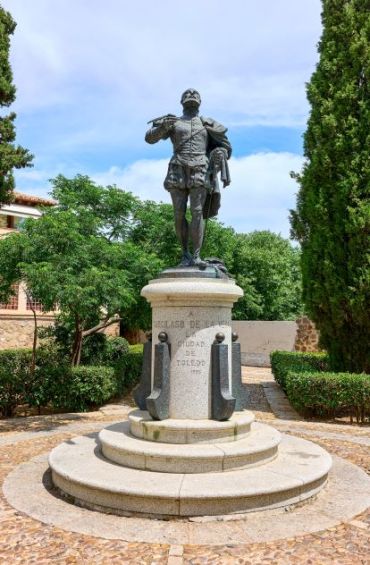 A statue of the renowned Garcilaso de la Vega in his home town of Toledo.
Credit: Shutterstock
A statue of the renowned Garcilaso de la Vega in his home town of Toledo.
Credit: ShutterstockIn his ode to the Italian, Garcilaso modestly claims he is not a very good poet, but that if he were, he would use his gifts to extol Bembo. He then goes on to do exactly that and praise Bembo’s poetry and work as an historian of Venice. Part of the aim of Garcilaso’s poem must have been to gain the approval of the older poet, which would admit him into the most elite literary circles of the period. (The strategy worked: Bembo wrote back to Garcilaso saying that he not only exceeded all Spanish poets, but even gave the Italians a run for their money.)
I was even more excited to notice the poems were followed by two more poems attributed to Garcilaso, and one of them was the poem dedicated to Bembo which had been lost for almost 500 years
The second poem is addressed to a German poet called Johann Alexander Brassicanus, who was not previously known to have a connection with Garcilaso. The poem describes tents and armies on the banks of the Danube, which suggests it refers to the period of exile. Until now, we have only had negative impressions of Garcilaso’s time in Germany, when he says he was ‘imprisoned […] in a foreign land’ (‘preso […] en tierra ajena’) and separated from his wife and family.
Now we have a more positive view, since in this poem Garcilaso speaks warmly of a friendship he made during that time: Brassicanus is ‘Among the first of my companions, bonded | To Lassus by undissolvable law | To the end of my life’ (‘sodalibus | In primis habite, indissociabili | Lasso lege revincte | Vitae tempora ad ultima’, 1–4). In short, these two poems give us new insights both into Garcilaso’s aspirations as a poet, as well as into parts of his fascinating life as a man of action.
I wrote an article about my discovery which has just come out in the Bulletin of Spanish Studies (https://www.tandfonline.com/doi/full/10.1080/14753820.2022.2122386). I hope the find will stimulate more interest in Garcilaso’s life and Latin poetry, and perhaps more odes will turn up when we least expect it.
John Fulljames will join the University in November as Director of the Humanities Cultural Programme. We sat down with him to hear about his previous roles as Director of the Royal Danish Theatre and Opera and as the creator of a successful arts start-up; why he is so excited to work with the University and the City of Oxford; and his vision for the HCP.
Tell us about your experience as Director of the Royal Danish Theatre and Opera.
I have been in Denmark over the last five years, which has been an extraordinary time in the world – and in the world of culture. The pandemic has challenged the relationship between cultural institutions and audiences. But it has also offered enormous opportunity as societies have seen new value in coming together for shared live experiences. I have been really amazed and proud of the Royal Danish’s audience, which is stronger now than it has been for 15 years. That is truly remarkable given the time we have been through.
How did you achieve that?
I think the reason is that we were already very focused on growing a younger and more diverse audience by ensuring that the projects which we were putting on the stage would resonate with them and by building trust that we would deliver positive experiences. We had a strong focus on communicating clearly and transparently to a wide range of different audiences. I hope we can use a similar approach here to build audience trust in the programme of the Schwarzman Centre.
You also launched and ran a start-up company called The Opera Group. Tell us more about that?
The Opera Group was a company that I set up in my early 20s along with some amazing colleagues. It grew to become a regular commissioner of contemporary opera and a tourer in the UK and beyond and really flourished as an associate company at the Young Vic in London. I loved the experience of growing an organisation from scratch, and building the partnerships and networks necessary for it to thrive. We were so conscious of the value which the company gained from working in partnership with the established Young Vic, and also what the energy of our young company brought to them.
There sound to be parallels to where the Humanities Cultural Programme is in this early stage. What do you hope to apply from your previous experiences to the HCP?
The crucial thing about growing a new enterprise is to convene and nurture a brilliant team of people. We have the chance to do that here in Oxford. I see so much potential in building on the success of TORCH and the HCP over the last few years as we seek to establish the new venue with a rich and diverse programme. I see this as an opportunity not only to create something new for Oxford, but to work with a new generation of artists and companies and support them to do things which have never been done before!
What interested you most about this job?
It is unique to have a multi-disciplinary arts centre which will sit at the core of three different communities: the Oxford city and region, the university community, and the international cultural community. If we can grow the programme with all of these communities, so that they can all recognise themselves in it, we should also be able to offer each of them new opportunities to connect with each other. There is a fantastic cultural ecology in Oxford of which the new building and programme will become part. That’s a cultural ecology of individual artists as well as institutions such as theatres, music organisations and museums. I look forward to being part of that and hope to develop a range of local partnerships to complement the international partnerships we want to form.
How will you go about making your programming resonate with these audiences?
The Schwarzman will be a public building in the heart of the University. So we will start from the perspective of the audience – what do they want and what isn’t available in the local cultural ecology? We need to find ways of involving people not just as audiences but also as we incubate and develop projects here in Oxford. We can do this in a very local way – the Schwarzman Centre will be a building for Oxford with content developed in Oxford. At the same time, we can do it in an international way by presenting world-class content which would otherwise not be seen in the region and which can attract both live audiences and digital audiences from around the globe.
Talking of the building (which will open in 2025), what do you think of the plans for the performance venues?
The Schwarzman Centre will be the first purpose-built concert hall space on this scale in Oxford and we look forward to filling what promises to be a really world-class hall with a diverse range of music that brings in many different audiences. But this is not just a music venue, it is a genuine multidisciplinary building. It has been designed to be able to share theatre, dance, music, film and exhibitions. None of those art forms operate in isolation from the others and I think one of the benefits of the building will be the synergies which emerge from the enormous range of creativity going on inside. Part of the intention of the architecture is that value will be released from bringing the many different departments which make up the humanities together in a building which enables conversation between them. The same will be true for arts and performance.
What is the impact for a cultural institution of being part of a university like Oxford?
That is what will make the programme unique. The HCP’s identity flows from being at the heart of a centre of cutting edge of contemporary thinking. It offers us the richest possible context for exploring ideas and engaging people in ideas. The HCP has such an important role to play in helping to open up this historic centre of excellence so that its many riches can be visible to, valued by, and in turn enriched by, more people than ever before.
The Schwarzman Centre provides an opportunity for Oxford University to be porous in a new way, as a public building with a civic purpose. The HCP has to make sure that everyone can walk through the door and feel they are welcome and that they belong. I cannot wait to get started.
Whatever Hollywood might say, AI is not all about killer robots in a far off future. It is more mundane, more everyday - and much more ubiquitous. And thinking it just belongs in a sci-fi film is dangerous, since this leads to a sense it is not relevant or that it is even unreal. Professor Ursula Martin bristles slightly at the very idea of robots, killer or otherwise, and points out that everyone’s lives are already affected by AI – and there are ‘bigger things at play’ than people realise.
The Maths professor and computer expert has put together a fascinating exhibition in the Bodleian about the history of AI – and has raided Oxford’s collections for treasures which showcase thinking about AI, illustrate fundamental ideas, and provoke debate.
AI is very useful. It’s all around us...It is changing our lives...Making...AI all about killer robots gets us off the hook of taking responsibility and distracts attention from the more everyday reality of AI
Professor Ursula Martin
Victor Frankenstein played God, she says, and Mary Shelley’s manuscript still has the power to shock. In the exhibition, it is open at the page where 'by the glimmer of the half-extinguished light' Frankenstein sees for the first time 'the dull yellow eye' of the creature he has created in his laboratory. Another exhibit is Ada Lovelace, describing Charles Babbage’s calculating machines. She places them in a contemporary theological debate: did the the creator of the machines challenge God, or merely help us to understand His works better?
Meanwhile, Ramon Lull’s colourful medieval diagrams present simple reasoning as an almost mystical process. But, for the 19th century economist Stanley Jevons, the goal was more mundane. His 'Logic Piano', a construction of ivory, wood, wire, showed, in principle, it was possible to mechanise human reason itself.
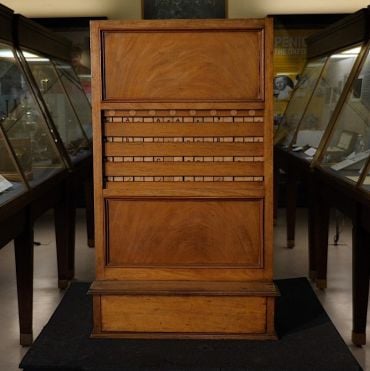 The logic piano
The logic pianoJonathan Swift, meanwhile, imagined a machine that could write a book on any topic ‘without the least assistance from genius or study’. And, in the early days of the computer, Christopher Strachey experimented with simple computer generated love-poems: the fore-runner of today’s AI software. It can mine millions of existing texts and 'learn' rules to create 'plausible' new texts about any given topic. Strachey’s programme used a very restricted vocabulary, which gave the poems an oddly prim and stilted tone.
Similarly, it is all too easy for modern AI to reflect biases in the texts it has learned from, propagating and amplifying those biases.
Professor Martin points out, to deliver modern AI involves vast quantities of data, and fast computers that use clever algorithms, not just for calculation, but to reason and find patterns too. Looking at early examples, such as Strachey’s poems, shows just how straightforward some of the underlying ideas are. According to Wadham College-based Professor Martin, it is the scale of the data and the power of the computation that transforms these simple ideas into present-day AI. Understanding them in context can give us new ways to think about contemporary concerns as well.
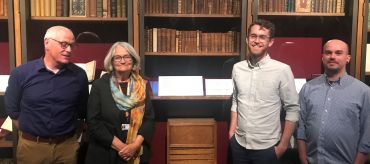 Professor Martin and the team
Professor Martin and the team‘There are so many stories you can tell from the Bodleian archives,’ Professor Martin says enthusiastically. ‘We’re trying to tell the history of AI here in 15 objects.'
So it is emphatically not all killer robots. Professor Martin adds, ‘AI is very useful. It’s all around us, for example your phone or your satnav or your bank are full of AI. It is changing our lives, and both as individuals and as society as a whole we need to think and act responsibly, just as we should with any other technology. Making conversations about AI all about killer robots gets us off the hook of taking responsibility and distracts attention from the more everyday reality of AI.’
- ‹ previous
- 7 of 247
- next ›
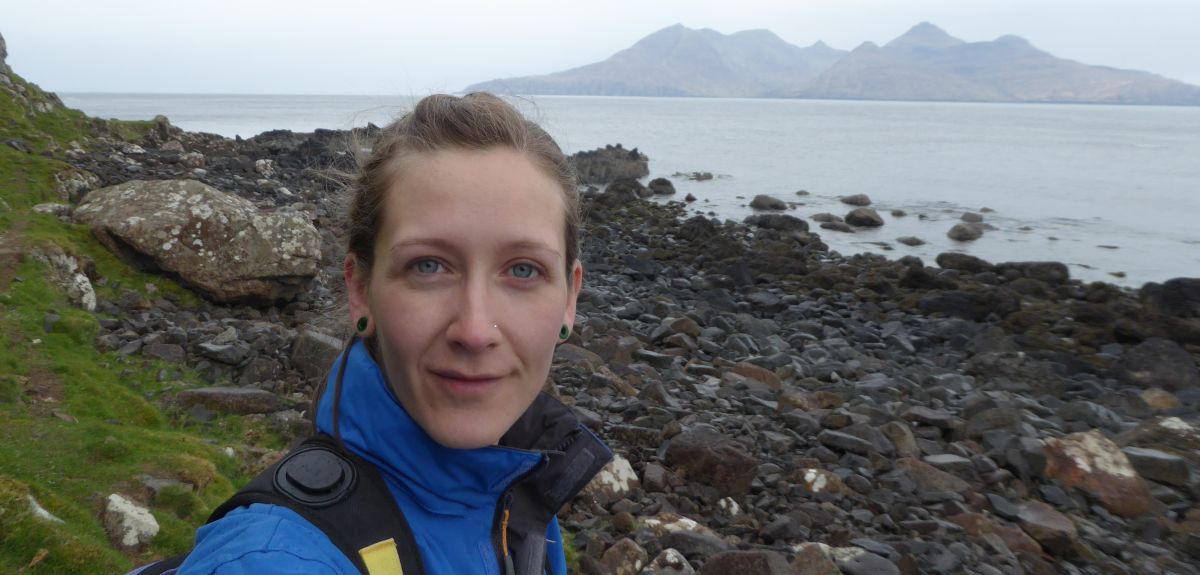

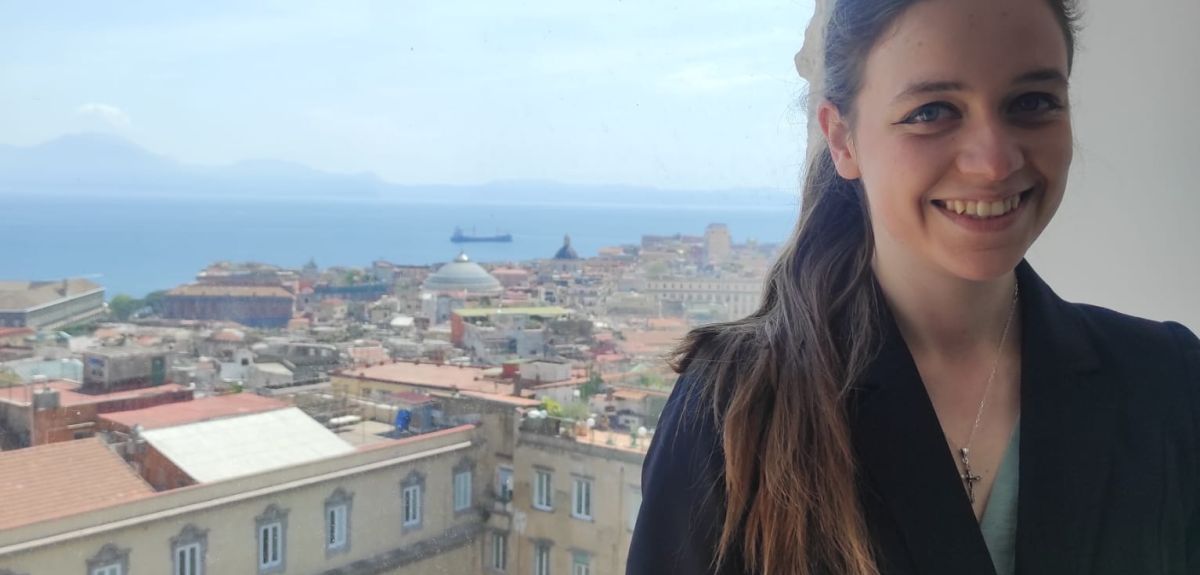
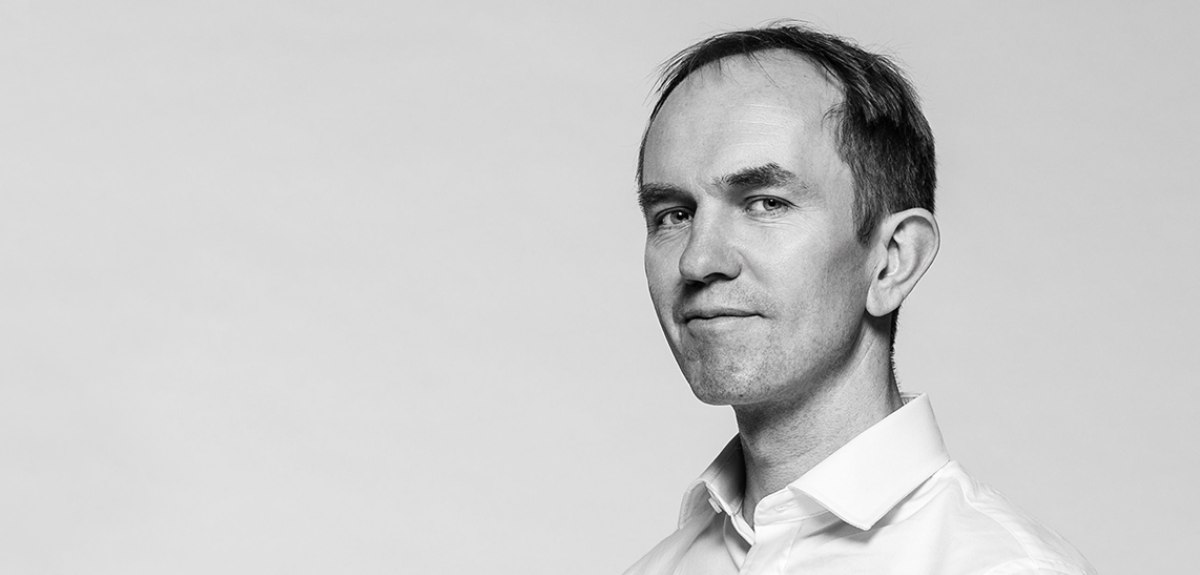
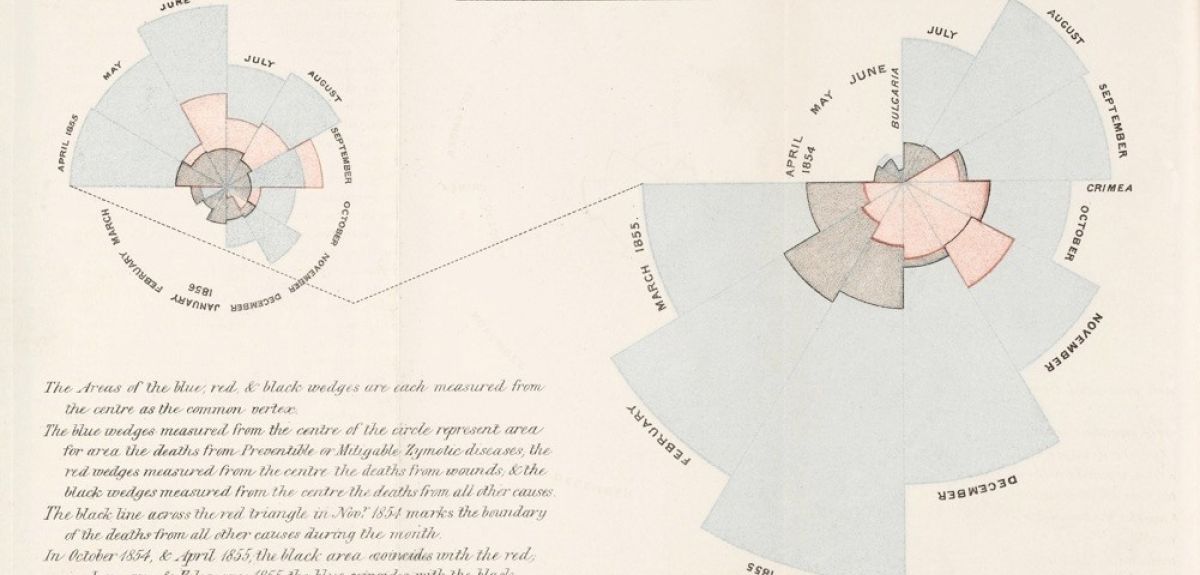
 World Malaria Day 2024: an interview with Professor Philippe Guerin
World Malaria Day 2024: an interview with Professor Philippe Guerin From health policies to clinical practice, research on mental and brain health influences many areas of public life
From health policies to clinical practice, research on mental and brain health influences many areas of public life From research to action: How the Young Lives project is helping to protect girls from child marriage
From research to action: How the Young Lives project is helping to protect girls from child marriage  Can we truly align AI with human values? - Q&A with Brian Christian
Can we truly align AI with human values? - Q&A with Brian Christian  Entering the quantum era
Entering the quantum era Can AI be a force for inclusion?
Can AI be a force for inclusion? AI, automation in the home and its impact on women
AI, automation in the home and its impact on women Inside an Oxford tutorial at the Museum of Natural History
Inside an Oxford tutorial at the Museum of Natural History  Oxford spinout Brainomix is revolutionising stroke care through AI
Oxford spinout Brainomix is revolutionising stroke care through AI Oxford’s first Astrophoria Foundation Year students share their experiences
Oxford’s first Astrophoria Foundation Year students share their experiences